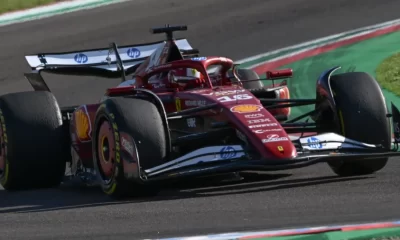Travel
Catania airport: Advice for travellers as airport stays closed until Tuesday
No flights to or from the UK and Ireland will land at Catania airport until 26 July.
Flights at Catania airport, on the southern Italian island of Sicily, are severely disrupted after a fire on Sunday night. No one was injured and the cause of the fire is as yet unknown.
The airport was meant to reopen earlier this week but authorities have now said that Terminal A, where the fire happened, will reopen on 24 July.
In the mean time, many flights are being cancelled or diverted to other airports in Sicily, which are struggling to cope with the sudden increase in passengers.
Catania’s Vincenzo Bellini Airport serves 91 destinations of which 24 are domestic, according to ItaliaRimborso. 100,000s passengers are predicted to be affected by the disruption.
Catania airport: Flights cancelled or moved to other airports
The situation at Catania airport is creating chaos for both inbound and outbound passengers during Sicily’s busy summer season.
As confirmed in a Notice to Airmen, no non-Schengen flights will land at or depart from Catania airport until 26 July. Non-Schengen countries include UK, USA, Ireland, Cyprus, Romania and Bulgaria. Here is a full list of non-Schengen countries.
In addition, only 4 flights will land at Catania airport per hour until 26 July.
Some airlines are proactively cancelling all flights, such as the UK’s Jet2 which has cancelled all flights in and out of Catania until 3 August.
While other airlines are diverting flights to other airports around Sicily. But many passengers are only being told where their flight leave from or land the night before they are due to travel.
Catania airport have said that they “are working to gradually improve the airport operations.” Evidence from the fire has now been collected and cleanup will begin today (Friday) in Terminal A.
Where are Catania flights being diverted to?
Flights are being diverted to other airports in Sicily such as Palermo, Trapani and Comiso.
Comiso airport is a two-hour drive from Catania airport; both are on the east of the island. Whereas Palermo and Trapani are on the west of the island therefore four-five hours drive from Catania.
Comiso and Trapani airports are significantly smaller than Catania airport so they are reported to be struggling with the sudden increase in flights and passengers. They have been described as being “in chaos” and “under stress” as workers try to process 6-7,000 more passengers than usual in temperatures above 40C.
It has also been reported that Sigonella, a military airport close to Catania, may also start to operate diverted flights.
How to travel between Sicily’s airports
Authorities say that free shuttles are being provided between Catania and Palermo, Comiso and Trapani airports, where flights are being diverted to. They have not given further information on where they are leaving from, capacity or how to ensure you have a seat.
However there are reports that information on this transport is being provided to passengers at airports and on incoming and outbound flights.
Along with the free transport being provided by the airports, Alibus has increased the frequency of its shuttle buses between Catania airport and the city centre. These will also stop at Catania’s main train station.
Trenitalia has increased the frequency of trains between Catania and Palermo airports.
There are car hire companies at Sicily’s airports but these are likely to be overwhelmed with demand.
Can you get to Sicily by train or ferry?
In short, yes.
On the east of the island, where Catania is, there are trains from Siracusa, a 1-hour drive from Catania, that take you to the Italian mainland where you can then connect to international trains.
There are also ferries from Palermo to Naples and Genova. Check GNV.it for more information on ferry routes.
Rome2Rio is an excellent travel planning website.
Catania airport cancellations: What should passengers do?
If you are due to fly into or out of Catania airport, the first step is to contact your airline or booking agent to find out if your flight is running.
This can be done via their website, app, email, phone or social media channels such as official Facebook and Twitter accounts.
If they contact you to say your flight will be diverted to another airport, you have the right to accept the change or request a refund – details should be given in their communication to you.
Bear in mind that there is likely to be a delay in receiving your refund as airlines will have many to process.
What is the advice from airlines?
Airlines are advising passengers to check their apps for flight information and updates.
Earlier this week Wizz Air issued a statement to passengers saying: “All affected passengers are being informed about the schedule changes, offered refund and rebooking options as well as hotel accommodation. Wizz Air will be keeping passengers informed via SMS/email about their flight’s status on 18th and 19th of July.”
Italy’s ITA Airways is rerouting some flights to Comiso airport, also on the east coast of Sicily. It has advised passengers to “check your flight status on Flight Info before travelling to the airport.”
Ryanair have said: “All passengers who have been affected by a cancellation or an airport change will be notified of their options.” They have also advised passengers to check the Ryanair app for updates.
Eurowings said yesterday (19 July) that all of their flights will be in and out of Palermo until 22 July.
Jet2 have cancelled all flights in and out of Catania until 3 August.
Other European airlines have been contacted for comment.
How have passengers reacted?
Travellers are taking to social media to express their discontent.
Many have said they have not received news on what is happening with their flights, with some saying they are waiting on hold on customer service phone lines for upwards of an hour with no response.
Users are frustrated that the airport was meant to reopen on Wednesday but their flights after that date are still being cancelled. One user said: “Catania airport says it reopened today but our flight for Thursday got cancelled. Have to drive to Palermo for a flight.”
Others are tweeting about experiences of friends and family flying into or out of Sicily.
Sicily is at the centre of European ‘heat storm’
Italy is currently in the grips of a major heatwave. Palermo, Sicily’s biggest city, is one of 16 Italian cities with heat warnings in place. Temperatures have reached 46°C and the heatwave is not forecast to break until 25 July.
Watch the video above to see more about Catania airport being closed.
Travel
Spain orders removal of more than 65,000 Airbnb tourist rentals it says violate regulations
ADVERTISEMENT
Spain has launched a major clampdown on Airbnb properties, ordering the removal of over 65,000 holiday rental listings across the country that fail to comply with regulations.
The Spanish Consumer Rights Ministry cited several violations, including missing licence numbers, not specifying whether the owner was an individual or a corporation, and discrepancies between listed information and official records.
The crackdown comes against the backdrop of Spain’s growing housing affordability crisis, which has sparked widespread protests over rising rents and home prices.
Many Spaniards blame short-term rentals on platforms like Airbnb for worsening housing shortages, particularly in popular tourist destinations like Madrid and Barcelona.
‘No more excuses’
On Monday, Spain’s Consumer Rights Minister Pablo Bustinduy said the move aimed to address the general “lack of control” and “illegality” in the holiday rental business.
“No more excuses. Enough with protecting those who make a business out of the right to housing in our country,” he told reporters.
The nationwide enforcement primarily targets listings in Madrid, Andalusia, and Catalonia, where tourism is most heavily concentrated.
The ministry said it had notified Airbnb about the noncompliant listings months ago, but that the company had appealed the move in court.
Spain’s government said Madrid’s high court had backed the order sent to Airbnb.
Bustinduy said it involved the immediate removal of 5,800 rental listings from the site. Two subsequent orders would be issued until the total of 65,935 removals is reached, he said.
Airbnb intends to appeal new ruling
Official data shows Spain had approximately 321,000 licensed holiday rentals as of November last year- a 15 per cent increase since 2020 – with many more operating without proper licenses.
The Consumer Rights Ministry opened an investigation into Airbnb in December last year.
Airbnb told Euronews Travel it will continue to appeal against all decisions linked to this case.
“No evidence of rule-breaking by hosts has been put forward, and the decision goes against EU and Spanish law, and a previous ruling by the Spanish Supreme Court,” a spokesperson said.
“The root cause of the affordable housing crisis in Spain is a lack of supply to meet demand. The solution is to build more homes – anything else is a distraction.”
The spokesperson added that governments across the world are seeing that regulating Airbnb does not alleviate housing concerns or return homes to the market: “It only hurts local families who rely on hosting to afford their homes and rising costs.”
Barcelona bans short-term rentals
Last year, the Spanish government launched a general crackdown on holiday rentals amid growing frustration among residents who say mass tourism is aggravating a housing crisis.
Locals say they are being priced out of their cities due to gentrification and landlords favouring more lucrative short-term tourist lets.
Barcelona has already taken aggressive measures to address the problem, announcing plans to eliminate all 10,000 licensed short-term rental apartments by 2028 to prioritise housing for permanent residents.
Travel
Brits could soon enjoy shorter passport control queues at EU airports. Here’s why
British holidaymakers will soon be able to use e-gates at more EU airports, the UK government has announced.
It comes as part of negotiations between the UK government and the European Union to finalise a ‘post-Brexit reset deal’.
It means British passport holders will no longer have to wait at manned desks and will instead be allowed to use fast-track e-gates usually reserved for EU or European Economic Area citizens.
EU Relations Minister Nick Thomas-Symonds said this would give British travellers “more time to spend on holiday or work trips […] doing what you want, not being stuck in queues.”
The UK government said the move would end “the dreaded queues at border control.”
UK travellers have to join ‘other nations’ queue at EU airports
Following Brexit, UK citizens forfeited their privileged status when travelling to EU countries.
They now fall into the ‘visa-exempt third-country nationals’ category – the same classification as travellers from dozens of countries, including Australia, Canada, New Zealand and Singapore.
This has meant British travellers must join the ‘other nations’ queue at border control rather than using the expedited EU lanes.
The requirement to check that British travellers meet entry conditions is a significant obstacle to allowing them to use the fast-track lanes.
EU border control has to verify that UK travellers are not in breach of the 90-day stay limit in 180 days and that they have the means to return to their country of origin, i.e. a flight ticket out of the EU.
Frontier officials must also stamp the passenger’s passport.
This change often translates to extended waiting times, especially at busy European airports like Amsterdam Schiphol, Milan Malpensa, and Paris Charles de Gaulle.
Waits exceeding an hour have become commonplace, especially when arriving shortly after large international flights.
These delays affect not only entry into EU countries but also departure, as British travellers must undergo exit checks that sometimes result in missed flights due to lengthy queues.
UK travellers will be able to use e-gates at many European airports
Under the new deal, British travellers will be able to take advantage of the faster e-gate passport checks at many EU airports.
No details have yet been released on when this will be introduced and where, although the BBC reported that British Prime Minister Keir Starmer “has called on all EU members to co-operate without delay.”
Some EU airports will likely allow UK travellers to use existing e-gates reserved for EU citizens, while others may install dedicated ‘third-country national’ e-gates.
The latter are already in place across Italy, including Venice Marco Polo and Rome Fiumicino, as well as at Amsterdam Schiphol and Lisbon.
With this system, once the traveller passes through the gate, there is a brief check by border officials who will also stamp passports.
Brits will use e-gates in all airports after introduction of EES
In addition, the UK government underlined that there will be “no legal barriers to e-gate use for British Nationals travelling to and from European Union Member States after the introduction of the European Union Entry/Exit System [EES].”
The EES is scheduled to come into force in October this year. The system will register non-EU visitors who don’t need a visa digitally, removing the need for physical stamps.
New pet passports will make it easier for Brits to bring pets into EU
The UK government also announced that new pet passports will be introduced as part of the deal.
This means UK cats and dogs will be able to travel “more easily” from the UK into the EU by “eliminating the need for animal health certificates for every trip.”
Travel
Brits will soon be able to dodge passport control queues by using e-gates at more European airports
Published on •Updated
ADVERTISEMENT
UK passport holders will soon be able to use e-gates at more EU airports, the UK government has announced.
It comes as part a “breakthrough” post-Brexit reset deal between the UK government and the European Union.
The UK government said the move would end “the dreaded queues at border control” with Brits being allowed to use fast-track e-gates usually reserved for EU or European Economic Area citizens at more airports.
EU Relations Minister Nick Thomas-Symonds said this would give British travellers “more time to spend on holiday or work trips […] doing what you want, not being stuck in queues.”
UK travellers have to join ‘other nations’ queue at EU airports
Following Brexit, UK citizens forfeited their privileged status when travelling to EU countries.
They now fall into the ‘visa-exempt third-country nationals’ category – the same classification as travellers from dozens of countries, including Australia, Canada, New Zealand and Singapore.
This has meant British travellers must join the ‘other nations’ queue at border control rather than using the expedited EU lanes. The requirement to check that British travellers meet entry conditions is a significant obstacle to allowing them to use the fast-track lanes.
EU border control has to verify that UK travellers are not in breach of the 90-day stay limit in 180 days and that they have the means to return to their country of origin, i.e. a flight ticket out of the EU.
Frontier officials must also stamp the passenger’s passport.
This change often translates to extended waiting times, especially at busy European airports like Amsterdam Schiphol, Milan Malpensa, and Paris Charles de Gaulle.
Waits exceeding an hour have become commonplace, especially when arriving shortly after large international flights.
These delays affect not only entry into EU countries but also departure, as British travellers must undergo exit checks that sometimes result in missed flights due to lengthy queues.
UK travellers will be able to use e-gates at many European airports
Under the new deal, British travellers will be able to take advantage of the faster e-gate passport checks at many EU airports.
No details have yet been released on when this will be introduced and where, although the BBC reported that British Prime Minister Keir Starmer “has called on all EU members to co-operate without delay.”
Some EU airports will likely allow UK travellers to use existing e-gates reserved for EU citizens, while others may install dedicated ‘third-country national’ e-gates.
The latter are already in place across Italy, including Venice Marco Polo and Rome Fiumicino, as well as at Amsterdam Schiphol and Lisbon.
With this system, once the traveller passes through the gate, there is a brief check by border officials who will also stamp passports.
Brits will use e-gates in all airports after introduction of EES
In addition, the UK government underlined that there will be “no legal barriers to e-gate use for British Nationals travelling to and from European Union Member States after the introduction of the European Union Entry/Exit System [EES].”
The EES is scheduled to come into force in October this year. The system will register non-EU visitors who don’t need a visa digitally, removing the need for physical stamps.
New pet passports will make it easier for Brits to bring pets into EU
The UK government also announced that new pet passports will be introduced as part of the deal.
This means UK cats and dogs will be able to travel “more easily” from the UK into the EU by “eliminating the need for animal health certificates for every trip.”
-

 EU & the World6 days ago
EU & the World6 days agoWho Is Valeria Marquez? About the Influencer Who Was Shot During Livestream
-

 EU & the World4 days ago
EU & the World4 days agoChris Brown Tour 2025: Updates on Concert Dates, Cities, Ticket Prices & More
-

 EU & the World5 days ago
EU & the World5 days agoWho Is Ben Cohen? About the Ben & Jerry’s Co-Founder Who Was Arrested During Senate Hearing
-

 EU & the World3 days ago
EU & the World3 days agoJosh Freese: 5 Things to Know About the Former Foo Fighters Drummer
-

 EU & the World5 days ago
EU & the World5 days agoChris Brown’s Net Worth: How Much Money He Makes Now
-
Travel7 days ago
Crete earthquake: Is it safe to travel to the Greek island following tsunami warning?
-

 Entertainment4 days ago
Entertainment4 days agoEurovision 2025: Music, Politics, and the Final 26 Set Amid Controversy and Spectacle
-

 Sports4 days ago
Sports4 days agoFerrari, opposing views after first day at Imola for Charles Leclerc and Lewis Hamilton









